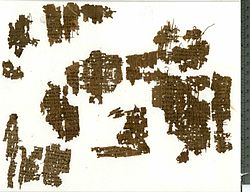
Papyrus Oxyrhynchus 5101
Papyrus Oxyrhynchus 5101, designated by 2227 (in the Alfred Rahlfs numbering of koine Greek Septuagint manuscripts), or P.Oxy.77 (LXXVII) 5101, is a manuscript of the Greek Septuagint Psalms (an ancient translation of the Hebrew Bible Psalms), written on papyrus in roll form. It has survived in a very fragmentary condition. Using the study of comparative writings styles (palaeography), it has been dated to the middle of the first - middle of the second century CE.

P.Oxy.77 5101 uses the Tetragrammaton (name of God in the Hebrew Bible) written in palaeo-Hebrew script instead of substituting it with the Greek title κύριος (kyrios / Lord), and is currently the earliest extant copy of the Septuagint Psalms.

Description
The manuscript was originally a papyrus roll, of which fragments from six columns have survived. The fragments contain Psalms 26:9-14; 44:4-8; 47:13-15; 48:6-21; 49:2-16; 63:6-64:5 according to the numbering of the Septuagint (the Hebrew Bible Psalms number them slightly differently). As noted by biblical scholar Larry Hurtado, "[t]his is probably the earliest extant copy of the Septuagint Psalms."[1] The text was written by an inexperienced writer in uncial script characters.

Greek text
Transcription of two of the Psalm verses according to biblical scholar Anthony R. Meyer:

Psalms 26:14 (27:14 MT)
[και εψευσατο] η α[δικια ε]αυτη
[πιστευω του ι]διν τα αγαθα
[εν γη ζωντων υπο]μενοντων τον[
]
[ανδριζου και κρ]αταιουσθω η καρδια σ[ου]
[και υπομεινο]ν τ[ον][2]: 234

Psalms 64:2 (LXX)
[.]. [ ] εις το τελψαλμος τω Δαυειδ [
[σοι πρ]επειυμνος εν Σειων [
[και σοι] αποδοθησεται ευχη [
[εισακο]υσον προσευχης: προς σε π[ασα[2]: 234
In the above verse, the Masoretic Text reads אלהים (elohim) and the LXX (Greek Septuagint) reads ο θεος (ho theos) but P. Oxy. 5101 reads YHWH.[2]: 233

Tetragrammaton
The manuscript contains the tetragrammaton to represent the Divine Name of God (YHWH) written in the palaeo-Hebrew script (![]()
![]()
![]()
![]() ).[3] This manuscript is not a recension and contains the name of God (YHWH) in Paleo-Hebrew letters, thus contradicting the argument that the presence of the tetragrammaton in Paleo-Hebrew letters is the product of a recension to the Hebrew text.[4]: 247 According to Meyer, the Greek scribe was not familiar with the tetragram, so instead of changing the original reading, he simply copied it from another manuscript that already contained it;[4]: 231 however it has also been argued that a blank space was left, and then the scribe himself decided to write YHWH in Paleo-Hebrew.[2]: 231 Meyer states that "still, the evidence of P. Oxy 5101 is too fragmentary to give decisive evidence for the procedure of writing the Tetragrammaton. If P. Oxy 5101 follows the procedure of other Greek biblical texts that write the Tetragrammaton in the paleo-Hebrew script, then it would represent a one-stage writing system".[2]: 247 He further comments:
).[3] This manuscript is not a recension and contains the name of God (YHWH) in Paleo-Hebrew letters, thus contradicting the argument that the presence of the tetragrammaton in Paleo-Hebrew letters is the product of a recension to the Hebrew text.[4]: 247 According to Meyer, the Greek scribe was not familiar with the tetragram, so instead of changing the original reading, he simply copied it from another manuscript that already contained it;[4]: 231 however it has also been argued that a blank space was left, and then the scribe himself decided to write YHWH in Paleo-Hebrew.[2]: 231 Meyer states that "still, the evidence of P. Oxy 5101 is too fragmentary to give decisive evidence for the procedure of writing the Tetragrammaton. If P. Oxy 5101 follows the procedure of other Greek biblical texts that write the Tetragrammaton in the paleo-Hebrew script, then it would represent a one-stage writing system".[2]: 247 He further comments:

While scholars agree that Greek texts with the Tetragrammaton contain evidence of revision towards a Hebrew exemplar, there are important exceptions, and with only a small pool of evidence, each exception becomes increasingly significant. P. Oxy 5101, for example, is a genuine OG [(Old Greek)] witness of the Psalter, but it also contains the paleo-Hebrew Tetragrammaton. Albert Pietersma states that '[o]n balance nothing impresses me more about 5101 than its early date and its thoroughly Septuagintal character notwithstanding its sole recensional trait, namely, the replacement of κύριος by the tetragram in palaeo-Hebrew script.' If the sole recensional trait is the Tetragrammaton, then the criteria used for establishing this recensional trait begins to break down. In a recent text-critical study, Jannes Smith also affirms the OG character of P. Oxy 5101. He agrees with Pietersma that the paleo-Hebrew Tetragrammaton is the 'recensional trait' of this manuscript, assuming that it has entered the text at some point in transmission history. Smith concludes his study by suggesting that because the Psalter has borrowed language from the Pentateuch it is likely to have emulated its (hypothetical) use of κύριος. Thus '[Ra] 2227 supports an argument in favour of an original κύριος, with the paleo-Hebrew form of the Tetragram as a secondary, archaizing stage'. Even though the important correlation between the recensional features of the manuscript and the presence of the Tetragrammaton is lacking, Pietersma and Smith maintain that the Tetragrammaton is a sign of revision.[2]: 247
Meyer concludes that "on the whole, this line of argumentation to establish the Tetragrammaton as a secondary development based on recensional traits of Greek texts is flawed", and "the presence of ιαω does not decisively answer the question of the earliest OG rendering".[4]: 249 He adds: "there is no proof that the reason for the Tetragrammaton is caused by or inherent to the textual character of early revisions of the Old Greek".[4]: 249 Whilst speaking concerning the idea of "recension" in regards to another Greek Septuagint manuscript classed among the Dead Sea Scrolls, the Greek Minor Prophets Scroll from Nahal Hever, which is considered to be a kaige recension of the Septuagint (a revision of the Old Greek text to bring it closer to the Hebrew text of the Bible as it existed in ca. 2nd–1st century BCE), biblical scholar Kristin De Troyer remarks: "The problem with a recension is that one does not know what is the original form and what the recension. Hence, is the paleo-Hebrew Tetragrammaton secondary – a part of the recension – or proof of the Old Greek text? This debate has not yet been solved."[5]

History
The manuscript was discovered at Oxyrhynchus (Egypt), and has been catalogued with number P. Oxy 5101. The manuscript has been given an Alfred Rahlfs number of 2227 in the list of Septuagint manuscripts. The fragments were published in 2011 by Danielę Colomo and W.B. Henry in The Oxyrhynchus Papyri, vol LXXVII (77).

The manuscript is currently housed in the Papyrology section of the Sackler Library at Oxford (shelf number 20 3B.36/J(4)B + 27 3B.38/N(1)B + 27 3B.41/J(1-2)c).

References
- ^ Hurtado, Larry (2013-03-02). "New Oxyrhynchus Manuscripts". Retrieved 12 November 2023.
- ^ a b c d e f Meyer, Anthony R. (2017). The Divine Name in Early Judaism: Use and Non-Use in Aramaic, Hebrew, and Greek (PhD diss. McMaster University).
- ^ Theophilos, Michael P. (2015). "Recently Discovered Greek Papyri and Parchment of the Psalter from the Oxford Oxyrhynchus Manuscripts: Implications for Scribal Practice and Textual Transmission" (PDF). Paradosis. 2. Australian Catholic University. Archived from the original (PDF) on 2019-03-14. Retrieved 2019-03-14.
- ^ a b c d Meyer, Anthony R. (2022). Naming God in Early Judaism: Aramaic, Hebrew, and Greek. Studies in Cultural Contexts of the Bible. Vol. 2. Leiden: Brill. ISBN 978-3-657-70350-0.
- ^ De Troyer, Kristin (2006). "The Choice is Yours! On Names of God". Journal of the European Society of Women in Theological Research. 14: 60. doi:10.2143/ESWTR.14.0.2019306.
Bibliography
- Colomo, Daniela; Henry, W. B. (2011). Oxyrhynchus Papyri LXXVII. The Egypt Exploration Society. pp. 1–11. ISBN 978-0-85698-204-0.
- Colomo, Daniela; Henry, W. B. "P. Oxy. 77 5101". Leuven Database of Ancient Books. Retrieved 22 May 2012.
- Smith, Jannes (2012). "The Text-Critical Significance of Oxyrhynchus Papyrus 5101 (Ra 2227) for the Old Greek Psalter" (PDF). Journal of Septuagint and Cognate Studies. 45 (7): 22.
External links
- D. Colomo; W. B. Henry. "P.Oxy.LXXVII 5101". Oxyrhynchus Online. The Oxyrhynchus Papyri vol. LXXVII. Retrieved 20 June 2013.
- "LDAB 140272". www.trismegistos.org. Retrieved 2023-10-24.
See what we do next...
OR
By submitting your email or phone number, you're giving mschf permission to send you email and/or recurring marketing texts. Data rates may apply. Text stop to cancel, help for help.
Success: You're subscribed now !




